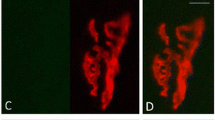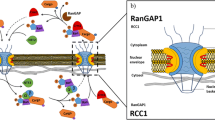Abstract
Progressive muscle atrophy and loss of muscle strength associated with old age have been well documented. Although age-associated impairments in skeletal muscle regeneration following injury have been demonstrated, less is known about whether aging impacts the regenerative response of neuromuscular junctions (NMJ) following contraction-induced injury. Reduced ability of NMJs to regenerate could lead to increased numbers of denervated muscle fibers and therefore play a contributing role to age-related sarcopenia. To investigate the relationship between age and NMJ regeneration following injury, extensor digitorum longus (EDL) muscles of middle-aged (18–19 months) and old mice (27–28 months) were subjected to a protocol of lengthening contractions (LC) that resulted in an acute force deficit of ~55% as well as functional and histological evidence of a similar magnitude of injury 3 days post LCs that was not different between age groups. After 28 days, the architecture and innervation of the NMJs were evaluated. The numbers of fragmented endplates increased and of fully innervated NMJs decreased post-injury for the muscle of both middle-aged and old mice and for contralateral uninjured muscles of old compared with uninjured muscles of middle-aged controls. Thus, the diminished ability of the skeletal muscle of old mice to recover following injury may be due in part to an age-related decrease in the ability to regenerate NMJs in injured muscles. The impaired ability to regenerate NMJs may be a triggering factor for degenerative changes at the NMJ contributing to muscle fiber weakness and loss in old age.






Similar content being viewed by others
References
Rydell-Tormanen K, Johnson JR. The applicability of mouse models to the study of human disease. New York, NY: Humana Press; 2019. https://doi.org/10.1007/978-1-4939-9086-3_1.
Xie WQ, He M, Yu DJ, Wu YX, Wang XH, Lv S, Xiao WF, Li YS. Mouse models of sarcopenia: classification and evaluation. J Cachexia Sarcopenia Muscle. 2021;12:538–54. https://doi.org/10.1002/jcsm.12709.
Wilkinson DJ, Piasecki M, Atherton PJ. The age-related loss of skeletal muscle mass and function: Measurement and physiology of muscle fibre atrophy and muscle fibre loss in humans. Ageing Res Rev. 2018;47:123–32. https://doi.org/10.1016/j.arr.2018.07.005.
Keller K, Engelhardt M. Strength and muscle mass loss with aging process. Age and strength loss. Muscles Ligaments Tendons J. 2013;3:346–50.
Goodpaster BH, Park SW, Harris TB, Kritchevsky SB, Nevitt M, Schwartz AV, Simonsick EM, Tylavsky FA, Visser M, Newman AB. The loss of skeletal muscle strength, mass, and quality in older adults: the health, aging and body composition study. J Gerontol A Biol Sci Med Sci. 2006;61:1059–64. https://doi.org/10.1093/gerona/61.10.1059.
Jang YC, Van Remmen H. Age-associated alterations of the neuromuscular junction. Exp Gerontol. 2011;46:193–8. https://doi.org/10.1016/j.exger.2010.08.029.
Doherty TJ, Vandervoort AA, Brown WF. Effects of ageing on the motor unit: a brief review. Can J Appl Physiol. 1993;18:331–58. https://doi.org/10.1139/h93-029.
Sonjak V, Jacob K, Morais JA, Rivera-Zengotita M, Spendiff S, Spake C, Taivassalo T, Chevalier S, Hepple RT. Fidelity of muscle fibre reinnervation modulates ageing muscle impact in elderly women. J Physiol. 2019;597:5009–23. https://doi.org/10.1113/JP278261.
Choi SJ, Lim JY, Nibaldi EG, Phillips EM, Frontera WR, Fielding RA, Widrick JJ. Eccentric contraction-induced injury to type I, IIa, and IIa/IIx muscle fibers of elderly adults. Age (Dordr). 2012;34:215–26. https://doi.org/10.1007/s11357-011-9228-2.
Hettinger ZR, Hamagata K, Confides AL, Lawrence MM, Miller BF, Butterfield TA, Dupont-Versteegden EE. Age-related susceptibility to muscle damage following mechanotherapy in rats recovering from disuse atrophy. J Gerontol A Biol Sci Med Sci. 2021;76:2132–40. https://doi.org/10.1093/gerona/glab186.
Manfredi TG, Fielding RA, O'Reilly KP, Meredith CN, Lee HY, Evans WJ. Plasma creatine kinase activity and exercise-induced muscle damage in older men. Med Sci Sports Exerc. 1991;23:1028–34.
Ploutz-Snyder LL, Giamis EL, Formikell M, Rosenbaum AE. Resistance training reduces susceptibility to eccentric exercise-induced muscle dysfunction in older women. J Gerontol A Biol Sci Med Sci. 2001;56:B384–B90. https://doi.org/10.1093/gerona/56.9.b384.
Volpi E, Nazemi R, Fujita S. Muscle tissue changes with aging. Curr Opin Clin Nutr Metab Care. 2004;7:405–10. https://doi.org/10.1097/01.mco.0000134362.76653.b2.
Vasilaki A, Pollock N, Giakoumaki I, Goljanek-Whysall K, Sakellariou GK, Pearson T, Kayani A, Jackson MJ, McArdle A. The effect of lengthening contractions on neuromuscular junction structure in adult and old mice. Age (Dordr). 2016;38:259–72. https://doi.org/10.1007/s11357-016-9937-7.
Kim C, Hwang JK. The 5,7-dimethoxyflavone suppresses sarcopenia by regulating protein turnover and mitochondria biogenesis-related pathways. Nutrients. 2020;12:1079. https://doi.org/10.3390/nu12041079.
Larkin LM, Davis CS, Sims-Robinson C, Kostrominova TY, Van Remmen H, Richardson A, Feldman EL, Brooks SV. Skeletal muscle weakness due to deficiency of CuZn-superoxide dismutase is associated with loss of functional innervation. Am J Physiol Regul Integr Comp Physiol. 2011;301:R1400–7. https://doi.org/10.1152/ajpregu.00093.2011.
Koh TJ, Peterson JM, Pizza FX, Brooks SV. Passive stretches protect skeletal muscle of adult and old mice from lengthening contraction-induced injury. J Gerontol A Biol Sci Med Sci. 2003;58:592–7. https://doi.org/10.1093/gerona/58.7.B592.
Brooks SV. Rapid recovery following contraction-induced injury to in situ skeletal muscles in mdx mice. J Muscle Res Cell Mot. 1998;19:179–87. https://doi.org/10.1023/a:1005364713451.
Brooks SV, Faulkner JA. Contractile properties of skeletal muscles from young, adult and aged mice. J Physiol. 1988;404:71–82. https://doi.org/10.1113/jphysiol.1988.sp017279.
Mayeuf-Louchart A, Hardy D, Thorel Q, Roux P, Gueniot L, Briand D, Mazeraud A, Bougle A, Shorte SL, Staels B, Chretien F, Duez H, Danckaert A. MuscleJ: a high-content analysis method to study skeletal muscle with a new Fiji tool. Skelet Muscle. 2018;8:25. https://doi.org/10.1186/s13395-018-0171-0.
Bhaskaran S, Pollock N, Macpherson PCD, Ahn B, Piekarz KM, Staunton CA, Brown JL, Qaisar R, Vasilaki A, Richardson A, McArdle A, Jackson MJ, Brooks SV, Van Remmen H. Neuron-specific deletion of CuZnSOD leads to an advanced sarcopenic phenotype in older mice. Aging Cell. 2020;19:e13225. https://doi.org/10.1111/acel.13225.
McCully KK, Faulkner JA. Injury to skeletal muscle fibers of mice following lengthening contractions. J Appl Physiol. 1985;59:119–26. https://doi.org/10.1152/jappl.1985.59.1.119.
Shafiee G, Keshtkar A, Soltani A, Ahadi Z, Larijani B, Heshmat R. Prevalence of sarcopenia in the world: a systematic review and meta- analysis of general population studies. J Diabetes Metab Disord. 2017;16:21. https://doi.org/10.1186/s40200-017-0302-x.
Gonzalez-Freire M, de Cabo R, Studenski SA, Ferrucci L. The neuromuscular junction: aging at the crossroad between nerves and muscle. Front Aging Neurosci. 2014;6:208. https://doi.org/10.3389/fnagi.2014.00208.
Balice-Gordon RJ. Age-related changes in neuromuscular innervation. Muscle Nerve Suppl. 1997;5:S83–7. https://doi.org/10.1002/(SICI)1097-4598(1997)5+%3C83::AID-MUS20%3E3.0.CO;2-Z.
Cardasis CA, LaFontaine DM. Aging rat neuromuscular junctions: a morphometric study of cholinesterase-stained whole mounts and ultrastructure. Muscle & Nerve. 1987;10:200–13. https://doi.org/10.1002/mus.880100303.
Fahim MA, Holley JA, Robbins N. Scanning and light microscopic study of age changes at a neuromuscular junction in the mouse. J.Neurocytol. 1983;12:13–25. https://doi.org/10.1007/bf01148085.
Fahim MA, Robbins N. Ultrastructural studies of young and old mouse neuromuscular junctions. J.Neurocytol. 1982;11:641–56. https://doi.org/10.1007/bf01262429.
Oda K. Age changes of motor innervation and acetylcholine receptor distribution on human skeletal muscle fibres. J Neurol Sci. 1984;66:327–38. https://doi.org/10.1016/0022-510X(84)90021-2.
Wokke JH, Jennekens FG, van den Oord CJ, Veldman H, Smit LM, Leppink GJ. Morphological changes in the human end plate with age. J Neurol Sci. 1990;95:291–310. https://doi.org/10.1016/0022-510X(90)90076-Y.
Chai RJ, Vukovic J, Dunlop S, Grounds MD, Shavlakadze T. Striking denervation of neuromuscular junctions without lumbar motoneuron loss in geriatric mouse muscle. PLoS One. 2011;6:e28090. https://doi.org/10.1371/journal.pone.0028090.
Brooks SV, Faulkner JA. Contraction-induced injury: recovery of skeletal muscles in young and old mice. Am J Physiol. 1990;258:C436–42. https://doi.org/10.1152/ajpcell.1990.258.3.C436.
McArdle A, Dillmann WH, Mestril R, Faulkner JA, Jackson MJ. Overexpression of HSP70 in mouse skeletal muscle protects against muscle damage and age-related muscle dysfunction. FASEB J. 2004;18:355–7. https://doi.org/10.1096/fj.03-0395fje.
Girard E, Barbier J, Chatonnet A, Krejci E, Molgo J. Synaptic remodeling at the skeletal neuromuscular junction of acetylcholinesterase knockout mice and its physiological relevance. Chem Biol Interact. 2005;157-158:87–96. https://doi.org/10.1016/j.cbi.2005.10.010.
Rogozhin AA, Pang KK, Bukharaeva E, Young C, Slater CR. Recovery of mouse neuromuscular junctions from single and repeated injections of botulinum neurotoxin A. J Physiol. 2008;586:3163–82. https://doi.org/10.1113/jphysiol.2008.153569.
Wood SJ, Slater CR. Safety factor at the neuromuscular junction. Prog Neurobiol. 2001;64:393–429. https://doi.org/10.1016/S0301-0082(00)00055-1.
Deschenes MR, Roby MA, Glass EK. Aging influences adaptations of the neuromuscular junction to endurance training. Neuroscience. 2011;190:56–66. https://doi.org/10.1016/j.neuroscience.2011.05.070.
Rudolf R, Khan MM, Labeit S, Deschenes MR. Degeneration of neuromuscular junction in age and dystrophy. Front Aging Neurosci. 2014;6:99. https://doi.org/10.3389/fnagi.2014.00099.
Valdez G, Tapia JC, Lichtman JW, Fox MA, Sanes JR. Shared resistance to aging and ALS in neuromuscular junctions of specific muscles. PLoS One. 2012;7:e34640. https://doi.org/10.1371/journal.pone.0034640.
Slater CR. 'Fragmentation' of NMJs: a sign of degeneration or regeneration? A long journey with many junctions. Neuroscience. 2020;439:28–40. https://doi.org/10.1016/j.neuroscience.2019.05.017.
Shi Y, Ivannikov MV, Walsh ME, Liu Y, Zhang Y, Jaramillo CA, Macleod GT, Van Remmen H. The lack of CuZnSOD leads to impaired neurotransmitter release, neuromuscular junction destabilization and reduced muscle strength in mice. PLoS One. 2014;9:e100834. https://doi.org/10.1371/journal.pone.0100834.
Zhao K, Shen C, Li L, Wu H, Xing G, Dong Z, Jing H, Chen W, Zhang H, Tan Z, Pan J, Xiong L, Wang H, Cui W, Sun XD, Li S, Huang X, Xiong WC, Mei L. Sarcoglycan alpha mitigates neuromuscular junction decline in aged mice by stabilizing LRP4. J Neurosci. 2018;38:8860–73. https://doi.org/10.1523/JNEUROSCI.0860-18.2018.
Fogarty MJ, Gonzalez Porras MA, Mantilla CB, Sieck GC. Diaphragm neuromuscular transmission failure in aged rats. J Neurophysiol. 2019;122:93–104. https://doi.org/10.1152/jn.00061.2019.
Strong R, Miller RA, Cheng CJ, Nelson JF, Gelfond J, Allani SK, Diaz V, Dorigatti AO, Dorigatti J, Fernandez E, Galecki A, Ginsburg B, Hamilton KL, Javors MA, Kornfeld K, Kaeberlein M, Kumar S, Lombard DB, Lopez-Cruzan M, et al. Lifespan benefits for the combination of rapamycin plus acarbose and for captopril in genetically heterogeneous mice. Aging Cell. 2022;21:e13724. https://doi.org/10.1111/acel.13724.
Carlson BM, Dedkov EI, Borisov AB, Faulkner JA. Skeletal muscle regeneration in very old rats. J Gerontol. 2001;56A:B1–B10. https://doi.org/10.1093/gerona/56.5.B224.
Lee AS, Anderson JE, Joya JE, Head SI, Pather N, Kee AJ, Gunning PW, Hardeman EC. Aged skeletal muscle retains the ability to fully regenerate functional architecture. Bioarchitecture. 2013;3:25–37. https://doi.org/10.4161/bioa.24966.
Kang H, Lichtman JW. Motor axon regeneration and muscle reinnervation in young adult and aged animals. J Neurosci. 2013;33:19480–91. https://doi.org/10.1523/JNEUROSCI.4067-13.2013.
Ng SY, Ljubicic V. Recent insights into neuromuscular junction biology in Duchenne muscular dystrophy: impacts, challenges, and opportunities. EBioMedicine. 2020;61:103032. https://doi.org/10.1016/j.ebiom.2020.103032.
Rice KM, Preston DL, Neff D, Norton M, Blough ER. Age-related dystrophin-glycoprotein complex structure and function in the rat extensor digitorum longus and soleus muscle. J Gerontol A Biol Sci Med Sci. 2006;61:1119–29. https://doi.org/10.1093/gerona/61.11.1119.
Hughes DC, Marcotte GR, Marshall AG, West DWD, Baehr LM, Wallace MA, Saleh PM, Bodine SC, Baar K. Age-related differences in dystrophin: impact on force transfer proteins, membrane integrity, and neuromuscular junction stability. J Gerontol A Biol Sci Med Sci. 2017;72:640–8. https://doi.org/10.1093/gerona/glw109.
Faulkner JA, Jones DA, Round JM. Injury to skeletal muscles of mice by forced lengthening during contractions. Q J Exp Physiol. 1989;74:661–70. https://doi.org/10.1113/expphysiol.1989.sp003318.
Rader EP, Faulkner JA. Recovery from contraction-induced injury is impaired in weight-bearing muscles of old male mice. J Appl Physiol. 2006;100:656–61. https://doi.org/10.1152/japplphysiol.00663.2005.
Funding
The authors acknowledge the generous funding support from the National Institute on Aging (AG051442) for this work.
Author information
Authors and Affiliations
Contributions
All authors contributed to the study conception and design. Data collection was performed by Thomas Paul, Peter Macpherson, Tara Janetzke, and Carol Davis. Analysis was performed by Thomas Paul and Peter Macpherson. The first draft of the manuscript was written by Thomas Paul, and all authors commented on previous versions of the manuscript. All authors read and approved the final manuscript.
Corresponding author
Ethics declarations
Conflict of interest
The authors declare no competing interests.
Disclaimer
The contents do not represent the views of the University of Michigan, the University of Liverpool, the National Institutes of Health, or the US Government.
Additional information
Publisher’s note
Springer Nature remains neutral with regard to jurisdictional claims in published maps and institutional affiliations.
About this article
Cite this article
Paul, T.A., Macpherson, P.C., Janetzke, T.L. et al. Older mice show decreased regeneration of neuromuscular junctions following lengthening contraction-induced injury. GeroScience 45, 1899–1912 (2023). https://doi.org/10.1007/s11357-023-00774-w
Received:
Accepted:
Published:
Issue Date:
DOI: https://doi.org/10.1007/s11357-023-00774-w




